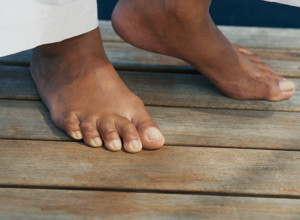Corns are raised hardened bumps or rough patches of skin on your toes, the sole of your foot or the heel. They might be yellow, waxy or flaky and sensitive to touch or cause pain when wearing footwear. They are not serious but can cause discomfort or pain, due to the irritation or inflammation caused by the pressure on the underlying skin. In order to keep or restore your personal comfort, it is important to treat your corns.
How to treat and remove corns?
Small corns generally require little to no treatment and usually go away by themselves if you avoid the pressure causing them. If you have a corn that causes irritation or pain, there are several ways to relieve the pressure and treat the corn. When treated, corns usually take about two to four weeks to disappear. In all cases, taking care of your feet, washing and drying them well and moisturising them regularly helps.
Corn Treatment – Remedies and Removals
Please note, that if you have insensitive skin due to poor circulation, diabetes or nerve damage, you should consult a chiropodist before treating your corns.
- Scraping – Trimming by scraping is generally only necessary for the removal of large painful corns. Scraping should be performed by a foot specialist. If you would like to trim your corn yourself you can file it.
- Filing – If you have a corn that is causing irritation, gently filing it down with a pumice stone might help to relieve pressure. It’s highly recommended to ensure the skin is moisturised/softened before filing. You should soak the corn in warm water for about 10 minutes beforehand to soften the skin. Dip the pumice stone in the water and then gently remove the dead skin by circular or sideways motions. Be careful not to remove too much skin as this might cause bleeding and infection. Instead, remove only small amounts and repeat the action regularly until the corn disappears.
- Non-prescription treatments and remedies – These treatments and remedies are usually based on cushioning the corn, rather than removing the corn. Compeed® Corn Plasters, for example, contain hydrocolloid technology, which provides pain relief by cushioning, protects your corn from further rubbing and at the same time moisturises the area around your corn, helping to remove it.Some of these over-the-counter treatments include salicylic acid, which helps to dissolve the keratin structure that makes up the dead skin. Salicylic acid treatment is available in different concentrations and comes as cream, pad, or plaster. You should consult a pharmacist for advice.Following the treatment, the dead skin will turn white and can be filed away. These treatments should only be used cautiously as the salicylic acid might irritate the surrounding healthy skin and should not be used on cracked corns. If you have diabetes or poor circulation, you should avoid these treatments, or consult your doctor or chiropodist before any treatment.
Prevention is key!
These treatments can help resolve the corn in around 2-4 weeks, but a corn generally returns, if the source of pressure causing it remains. Therefore, it is important to find the source of the pressure and avoid it. This is most often achieved by simply changing to more comfortable footwear or use padding (moleskin or adhesive pads available in pharmacies) until new shoes are broken in. In some cases, insoles might help. Only in rare cases medical intervention is required.
When should I seek medical advice?

Although corns are not serious, they can cause irritation, inflammation or even ulceration. If you experience severe inflammation or pain, you should seek medical advice.
If you are unsure if what you have is a corn, you are advised to consult a doctor or other appropriate healthcare professional.
Frequently reappearing corns might be caused by foot abnormalities, such as deformities, structural abnormalities of the bones, poor bone alignment or an abnormal gait. If you are concerned by the frequency or persistency of your corns, you might want to visit a doctor or podiatrist in order to rule out or detect any of these underlying causes. In these cases a specific padding or shoe insert might help you to prevent corns from reappearing. In rare cases, surgery might be necessary.







